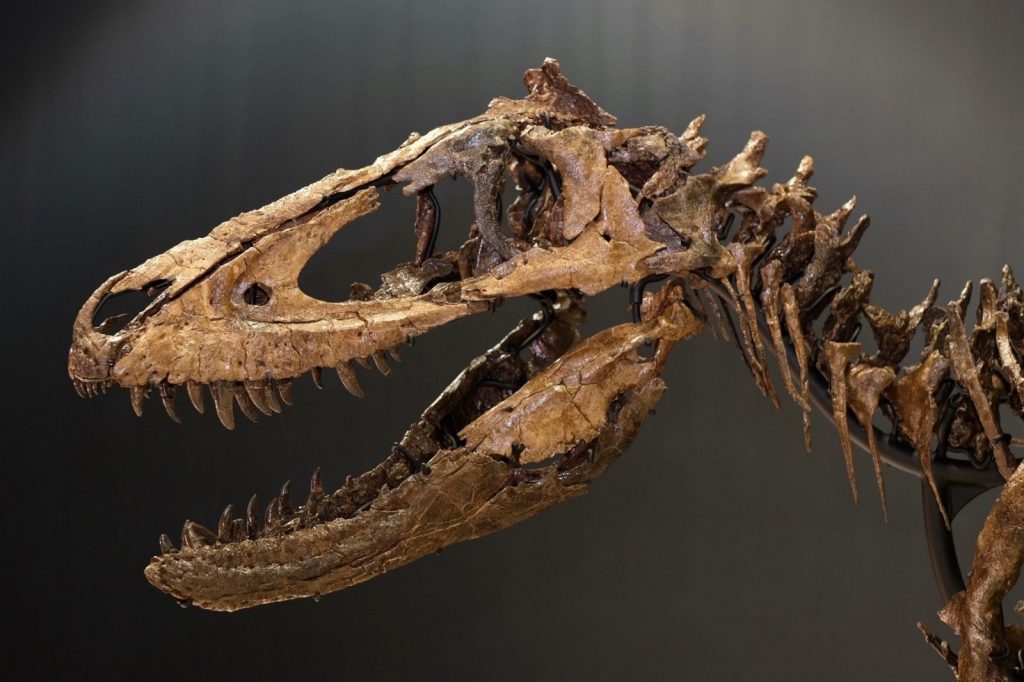Dominating the artistic landscape at Frieze Masters this week is a truly extraordinary offering – a dinosaur skeleton, a stark departure from the conventional paintings and sculptures on display. Meet ‘Chomper,’ a juvenile Tyrannosaurus Rex, and a remarkably well-preserved specimen, now available for acquisition through the reputable London-based gallery, David Aaron, with a staggering price tag of $20 million.
Chomper’s origins trace back some 68 million years to the Late Cretaceous period, and its story is nothing short of enthralling. Discovered in 2019 in Garfield County, Montana, the painstaking process of unearthing this ancient relic took years and was even documented in parts by the Discovery Channel series, “Dino Hunters.”
While the entire skeleton is about 55 percent complete, the skull itself is an impressive 90 percent intact, housing an astonishing number of original teeth. Prospective buyers will be provided with a comprehensive map of the dinosaur, delineating which bones are present and which may be missing, ensuring a complete understanding of the acquisition.
What makes this spectacle even more remarkable is the fact that Chomper is available for purchase at an art fair. Typically, fossils of such historical significance find their way to high-profile auctions, where they draw attention from collectors with diverse interests that may not necessarily align with traditional art acquisitions. Notably, in 2020, Christie’s set a new record by auctioning Stan, one of the largest and most complete T. rex fossils, for a jaw-dropping $31.8 million. Just last December, Sotheby’s sold a skull from the same species for $6.1 million.
However, as the market for prehistoric skeletons gains strength, dinosaurs are beginning to grace fair booths. David Aaron, a gallery specializing in “important items of natural history” and a variety of historical art, is at the forefront of this trend. At Frieze Masters in 2022, the gallery successfully sold a complete 154 million-year-old Camptosaurus skeleton for £1 million ($1.2 million). Earlier in the same year, during Masterpiece London, it discreetly handed over the skull of a triceratops to a private collector for an undisclosed sum.

Salomon Aaron, the gallery’s director, elucidated on their approach to this unique market segment, saying, “It’s an area that’s been overlooked, partly due to presentation. As an art gallery, we seek historically significant yet aesthetically captivating fossils. We apply the same rigor of due diligence, refined in the art market, to fossils. This approach offers buyers a more secure understanding of their purchase, enabling them to gauge its significance relative to other specimens.”
Despite the steep learning curve and the eye-watering prices, these ancient skeletons have an intrinsic appeal that transcends cultural and age boundaries, as Aaron explained, “It’s something all humans can relate to, irrespective of culture or age.” And, in the case of Chomper, he added, “it’s a once-in-a-lifetime discovery.”
Nonetheless, a $20 million price tag is undeniably substantial, even for an art fair. The question that looms is whether the gallery will find a buyer, and that, for now, remains uncertain.
FAQ
Can I learn guitar on my own at home?
Yes, it is possible to learn guitar on your own at home. With the abundance of online tutorials, instructional videos, and learning apps available, self-guided learning has become increasingly popular. Many beginners have successfully taught themselves to play the guitar by following structured lessons, practicing regularly, and using online resources. However, progress may vary depending on individual dedication, discipline, and learning style.
Can I learn guitar in 20 days?
Learning to play the guitar in just 20 days can be a challenging endeavor. While it’s possible to acquire basic skills and play simple songs in a short period, becoming proficient and mastering the instrument typically requires more time and consistent practice. The timeline for learning the guitar varies from person to person, and factors such as prior musical experience, the amount of time invested, and the complexity of your goals will impact your progress.
Can I learn guitar without a teacher?
Yes, it is possible to learn guitar without a teacher, thanks to the wealth of online resources and instructional materials available. Many self-taught guitarists have achieved a high level of proficiency by using books, online tutorials, apps, and instructional videos. However, working with a qualified guitar teacher can provide personalized guidance, feedback, and a structured learning path, which can accelerate your progress and help you avoid developing bad habits.
What is the first step to learning guitar?
The first step in learning to play the guitar is to acquire a suitable instrument. You can start with either an acoustic or electric guitar, depending on your musical preferences. Once you have a guitar, begin by learning the basic elements, such as the names of the strings and how to tune your instrument. Afterward, focus on fundamental techniques like finger positioning, chord shapes, and strumming or picking. It’s essential to practice regularly, start with simple songs, and gradually progress to more complex music as you build your skills. Consider using online tutorials, beginner courses, or seeking guidance from a teacher to ensure you develop a strong foundation in guitar playing.
